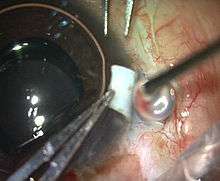Fibrin glue
Fibrin glue (also called fibrin sealant) is a surgical formulation used to create a fibrin clot for hemostasis or wound healing.[1][2][3][4][5][6][7]

Medical uses
It can be used to treat pilonidal sinus disease but it is of unclear benefit as of 2017 due to insufficient research.[8]
Composition
It is made up of fibrinogen (lyophilised pooled human concentrate) and thrombin (bovine, which is reconstituted with calcium chloride)[1] that are applied to a site of tissue damage to glue them together.[1] Thrombin is an enzyme and converts fibrinogen into fibrin monomers between 10 and 60 seconds giving rise to a three-dimensional gel.[6][9]
Factors affecting structure
Factors that influence dimensional structure of fibrin gel giving rise to fine or coarse gel:
- Changing concentration of fibrinogen
- Changing concentration of thrombine- increase concentration increases ultimate tensile strength and youngs modulus of gel
- Changing concentration of calcium
- pH
- Temperature
Formulations from different manufacturers may also contain aprotinin, fibronectin and plasminogen.[10] This glue can be used for repairing dura tears, bronchial fistulas and for achieving hemostasis after spleen and liver trauma.[6] It is also employed in "no sutures" corneal transplantation, pterygium excision with amniotic membrane or conjunctival autograft, and in ocular trauma for corneal or conjunctival defects.[11][12][13] It can also be used for skin graft donor site wounds to reduce postoperative pain.[14]
References
- Atrah HI (April 1994). "Fibrin glue". BMJ. 308 (6934): 933–4. doi:10.1136/bmj.308.6934.933. PMC 2539755. PMID 8173397.
- Thompson DF, Letassy NA, Thompson GD (December 1988). "Fibrin glue: a review of its preparation, efficacy, and adverse effects as a topical hemostat". Drug Intelligence & Clinical Pharmacy. 22 (12): 946–52. doi:10.1177/106002808802201203. PMID 2468466.
- "Fibrin Glue for Anal Fistula - Digestive Disorders / Gastroenterology". MedHelp.
- Shinohara K, Kobayashi E, Yoshida T, Toyama N, Kiyozaki H, Fujimura A, Miyata M (1998). "Effect of fibrin glue on small and large bowel anastomoses in the rat". European Surgical Research. Europaische Chirurgische Forschung. Recherches Chirurgicales Europeennes. 30 (1): 8–12. doi:10.1159/000008552. PMID 9493689.
- Spotnitz WD, Mintz PD, Avery N, Bithell TC, Kaul S, Nolan SP (August 1987). "Fibrin glue from stored human plasma. An inexpensive and efficient method for local blood bank preparation". The American Surgeon. 53 (8): 460–2. PMID 2440358.
- Saxena S, Jain P, Shukla J (2003). "Preparation of two component Fibrin Glue and its clinical evaluation in skin grafts and flaps". Indian J Plast Surg. 36 (1): 14–17.
- Mücke T, Wolff KD (2009). "Performing microvascular anastomosis with fibrin glue--faster, easier, and more reliable?". Microsurgery. 29 (1): 80–1. doi:10.1002/micr.20556. PMID 18946885.
- Lund, Jon; Tou, Samson; Doleman, Brett; Williams, John P (13 January 2017). "Fibrin glue for pilonidal sinus disease". Cochrane Database of Systematic Reviews. 1: CD011923. doi:10.1002/14651858.CD011923.pub2. PMC 6464784. PMID 28085995.
- Spotnitz WD (April 2010). "Fibrin sealant: past, present, and future: a brief review". World Journal of Surgery. 34 (4): 632–4. doi:10.1007/s00268-009-0252-7. PMID 19820991.
- "Tisseel". Swedish official drug catalog.
- Narendran N, Mohamed S, Shah S (July 2007). "No sutures corneal grafting--a novel use of overlay sutures and fibrin glue in Deep Anterior Lamellar Keratoplasty". Contact Lens & Anterior Eye. 30 (3): 207–9. doi:10.1016/j.clae.2007.02.007. PMID 17379570.
- Dal Pizzol MM, Roggia MF, Kwitko S, Marinho DR, Rymer S (2009). "[Use of fibrin glue in ocular surgery]" [Use of fibrin glue in ocular surgery]. Arquivos Brasileiros de Oftalmologia (in Portuguese). 72 (3): 308–12. doi:10.1590/s0004-27492009000300006. PMID 19668958.
- "Fibrin Sealant Fibrin Gluing Haemostasis autologous". vivostat.com.
- Sinha S, Schreiner AJ, Biernaskie J, Nickerson D, Gabriel VA (November 2017). "Treating pain on skin graft donor sites: Review and clinical recommendations". The Journal of Trauma and Acute Care Surgery. 83 (5): 954–964. doi:10.1097/TA.0000000000001615. PMID 28598907.